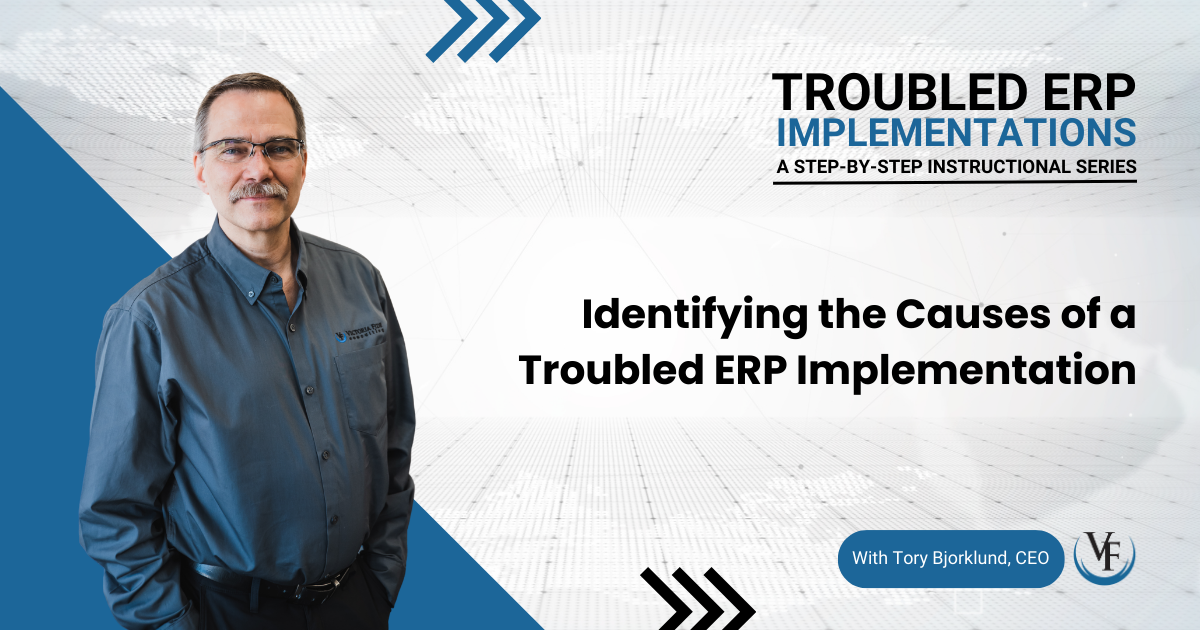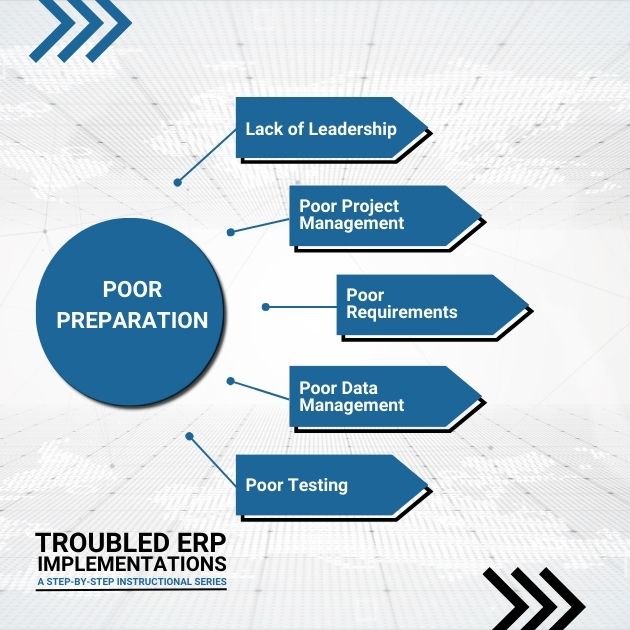
Identifying the Causes of a Troubled ERP Implementation
You have probably heard the shocking statistic that over 70% of ERP system implementations fail. The reality is that some 20% of these projects never get completed, and nearly half are at least 100% over budget.
The claimed number of failed ERP implementations is shocking, but if you define success as on-time, within-budget and satisfying the originally anticipated scope, it is surprising to me that the number isn’t higher. It is quite difficult to estimate an ERP implementation, and managing the scope to align with the initial agreement is even more difficult. For those of us who have been involved in large ERP implementations, we are not surprised that so many implementations are in trouble. In a previous article I discussed how to recognize when your ERP implementation is in trouble. If you have a troubled ERP implementation and you want to rescue it, you will first need to understand what caused the trouble.
Table of Contents
Causes of Trouble
If you search the internet for causes of ERP implementation failure, you will find several lists. The most commonly stated causes are:
- Lack of Leadership (Lack of ownership, lack of commitment, lack of accountability, etc.)
- Poor Project Management (Unrealistic schedule, poor scope management, not managing budget or timeline, etc.)
- Poor Requirements (inaccurate requirements, poor fit, incorrect scope, customizing to look like legacy system, etc.)
- Poor Data Management (Data cleansing, data migration, data management, etc.)
- Poor Testing
In my opinion, all of these issues (and many others) could be traced back to poor preparation. The reality is that most ERP implementations are poorly planned and the companies that undertake these projects are poorly prepared. Those who are leading the initiative simply don’t know what is necessary to succeed.

Fundamental Elements for Preparedness
The primary cause of ERP implementation trouble is poor preparation. To understand what constitutes poor preparation, it is helpful to understand what good preparation looks like. Good preparation involves several key elements that are crucial for a successful ERP implementation:
Clearly defined and articulated business objectives: It is essential to have clearly articulated business objectives that outline the desired outcomes of the ERP implementation. These objectives should be documented and communicated to all stakeholders and project participants to ensure everyone is aligned.
Context within an overarching roadmap: The ERP implementation should always be viewed within the context of a broader roadmap that outlines the organization’s long-term goals and strategies. This ensures that the implementation is aligned with the overall direction of the business and helps prioritize the necessary activities.
Realistic budget with a low and high range: A realistic budget should include a low and high range to provide enough detail to justify the financial resources required for the project. It should also account for potential contingencies. Here’s a resource for accurate budgeting for a digital transformation project: Budgeting for Digital Transformation: The Power of Truth in Achieving Success – Victoria Fide Consulting
Business justification for ERP implementation: Having a clear business justification for undertaking the ERP implementation includes identifying the expected return on investment (ROI) and establishing metrics to measure and report on those benefits.
Documented project roles and responsibilities: Roles and responsibilities within the project should be clearly defined and documented using a Responsibility Assignment Matrix (a.k.a. RACI matrix). ERP implementations experience improved coordination, communication, and efficiency when everyone involved understands their specific roles and responsibilities.
Adequately trained and experienced project participants: The project team should consist of individuals who possess the necessary training and experience to effectively execute the ERP implementation. In addition, adequate availability of team members is crucial to ensure their active participation.
Clearly defined and documented Risk Management Plan: A comprehensive risk management plan should be developed to identify potential risks and outline strategies for mitigating them. This plan should be well-documented and regularly updated throughout the implementation process.
Current risk list with mitigation plans: Alongside the risk management plan, a current risk list that identifies potential risks and their corresponding mitigation plans is essential in coordinating proactive monitoring and management of risks throughout the implementation.
Clearly defined and documented change management plan: Change management is a critical aspect of successful ERP implementations. A well-defined change management plan should be in place to address the people and process changes that accompany the new ERP system. This plan should include strategies for communication, training, and addressing resistance to change.
Realistic, resourced project plan: The project plan should realistically take into account the scope, timeline, and available resources. It doesn’t do anybody any favors to create a project plan that is overly optimistic and ignores vital factors. The project plan should clearly outline the activities, milestones, and dependencies involved in the implementation process, as well as entry and exit criteria for each milestone to ensure progress can be measured effectively.
Identified and rectified Skills Gaps: In addition to gaps in technical skills and experience, common skills gaps include the ability to accurately estimate work, the ability to create and manage a realistic project plan, and the ability to recognize and mitigate potential risks. It’s crucial to identify and rectify any skills gaps within your project team prior to kick-off.
Realistic and well-communicated expectations: With the proper preparation, a realistic project plan should dispel any unrealistic expectations, allowing all team members to be on the same page and know what to expect.
Aligned priorities: Aligning priorities prior to kick-off ensures that the efforts and resources invested in the ERP implementation are directed towards common goals, fostering collaboration, efficiency, and successful outcomes. This alignment enhances the likelihood of achieving the desired results and maximizing the benefits of the ERP system.
Adequate oversight: Lacking a line of sight for dependencies can lead to delays and bottlenecks. Strong leadership provided by a steering committee ensures strategic alignment, decision-making, and accountability throughout the project. Effective project management with oversight ensures that timelines, budgets, and deliverables are on track, mitigating risks and addressing issues promptly.
Data Migration Plan: A data migration plan is a strategy for transferring data from one system to another without losing information. A data migration plan should include a list of all data that will be migrated, if and how the data will be cleansed as part of the migration, the method that will be used for the migration, how the migration will be validated and who is responsible for each step in the migration.
Testing Plan: A test plan is used to guide the testing process to ensure the quality of the implementation. The test plan should be defined for each stage of testing, including unit testing (for custom development), functional testing, business simulation testing, user acceptance testing, and system integration testing. The plan should specify what environments will be used for the testing and how the test data will be managed. It should also specify how the tests will be managed, how the defects will be managed, who is responsible for each task, and what constitutes completion of testing.
Training Plan: A training plan is necessary to ensure everyone is in agreement with how users will be trained and who will be responsible for the various roles and responsibilities. It should include what method of training will be used (i.e. on-site classroom style, online webinar, video, self-directed, etc.), who will develop the training material, who will present the training, how the training follow-up will be handled.
Performing the Assessment: How to Identify the Cause
If your ERP implementation is in serious danger of failing, you should stop project operations immediately while you assess the root causes of the trouble. See my previous article for more information on why that is necessary. Once the project activities have halted, utilize your project team to assess the causes and prepare to execute differently.
There are two main areas of assessment that are necessary: Current State and Root Causes. Your project team plays a critical role in gathering information and providing insight into the state of the troubled implementation to get to the bottom of what went wrong. Their unique perspective and experience with the project will be integral in both assessing as well as preparing to execute differently in the future.
Assessing the Current State
In a troubled implementation, many people will want to start by asking, “What went wrong?” It is my experience that you cannot determine what went wrong without a clear picture of the current state of the project. It is also my experience that the team’s understanding of the current state of the project is based on unreliable information and is likely wrong. Some of the information may be correct, but it is difficult to determine what information to rely on.
The solution is to undertake assessment activities to establish reliable information concerning the state of the implementation. The key here is to “trust but verify.” Ask for the information, then validate the information.
What information do you need to acquire?
Start by gathering project related documentation and ask the following questions:
- Charter: Is the project still aligned with the initial charter, or have there been deviations?
- Responsibility Assignment Matrix (a.k.a. RACI matrix): Are the agreed-upon accountabilities being followed?
- Risk list: Is it up to date, and have any mitigation plans been executed?
- Project Plan: Is it current, complete, and being adhered to? What is the history of estimation versus actual results?
- Data Migration plan: Has it been followed, and is it functioning as intended?
- Environment Management Plan: Has it been followed, and is it effective?
- Outstanding issues: Is there a list of outstanding issues with their respective responsibilities?
- Completed issues: Try to obtain a list of all issues that have been addressed and their outcomes. It is important to verify that the reported issues have indeed been addressed.
- Remaining work items or backlog: What work items have already been identified as needing to be accomplished? Verify that the list has been approved by stakeholders and decision makers.
- Process Designs: Are the in-scope processes defined and documented? The primary focus of an ERP implementation should be to enable the efficient execution of business processes. If the processes are not defined and documented, you cannot successfully implement them.
- Training plan: Is there a predetermined plan of how the users will be trained? Is the plan documented and has it been followed?
- Standard Operating Procedures: Are there any written SOPs? Depending on the stage of the project, there should be written SOPs. If the project has reached the point of User Acceptance Testing, there should be written SOPs and a defined process for maintaining them.
- Test plan: Is there a predetermined plan of how the implementation will be tested? Is the plan documented and has it been followed?
- Test scenarios: Unless the project is very early in execution, you should expect to see a significant list of test scenarios.
- Test results: If there has been any testing conducted on the project, you will need to know how much testing has occurred and what is the failure rate.
- Outstanding bugs: If there has been any testing conducted on the project, you will need to know how many bugs still need to be resolved.
- Completed bugs: It is crucial to verify that the reported bugs have been adequately addressed and successfully tested. You will also want to determine the quality of the implementation based on the number of bugs logged for the amount of testing that has been conducted.
Assessing the Root Causes and Issues
Once you have reviewed the current state of the project, you can begin to identify what went wrong. Be careful not to fixate on the symptoms but work to get to the root causes. For example, missing project milestones is a symptom, not a root cause. If you miss milestones, there must be an underlying reason for it, such as poor estimating, competing priorities, skills gaps, etc.
Make sure all project participants and stakeholders get a chance to weigh in at some level. Not everyone will be able to be involved in every discussion, but all relevant participants should have an opportunity to provide their perspective. Be forewarned, however: you won’t be able to get everyone to agree on the issues, much less the root causes. You need to simply listen to them and then make your determination based on their experience and the information gathered in the assessment.
This is where experience is critical. If you haven’t been involved in several ERP implementations, seek expert advice from a trusted advisor with a proven track record in successful ERP implementations. Their expertise will assist you in identifying the root causes of trouble in your specific implementation.
If you are realizing that your ERP implementation is facing challenges due to poor preparation and may be headed for trouble, there’s no need to panic. We regularly rescue troubled projects, and our proven process provides the necessary framework for transformational success. The first step to rescuing your troubled implementation is to stop all project activities. Click here to read more about why stopping could be the quickest path to success. Once you’ve halted the project and assessed the current state and the root issues, then you will be ready to perform the steps for proper preparation.
Ensuring ERP Success with Proper Preparation
As we’ve explored the intricacies and challenges surrounding ERP projects, it’s evident that poor preparation is the common denominator in failed implementations. To mitigate risks and pave the way for an effective implementation, investing time and effort in comprehensive preparation is non-negotiable.
Our commitment at Victoria Fide Consulting is to guide you through this critical Prepare phase, ensuring each element is addressed with precision and discipline and laying the foundation for a positive digital transformation. Don’t let your ERP journey be marred by unanticipated hurdles—take proactive steps to fortify your project from the outset. Schedule a free 30-minute consultation with our founder and CEO, Tory Bjorklund, and discover proven action steps that will steer your project toward a successful finish.

About the Author
Tory Bjorklund, a seasoned leader in the consulting, manufacturing, and software sectors, currently holds the position of CEO at Victoria Fide. With a remarkable career that spans roles such as CEO, CTO, CIO, and Chief Software Architect, Tory consistently demonstrates his bold and visionary thinking. His enthusiasm for harnessing technology to transform businesses is evident, and he fervently advocates for reshaping conventional norms in digital transformation through Making Change Positive. Connect with him on LinkedIn to follow his journey.
